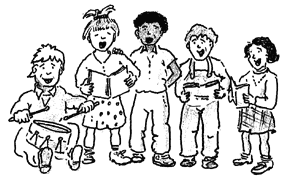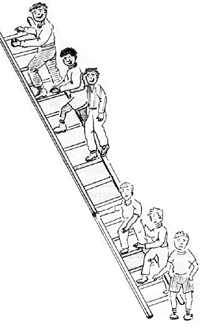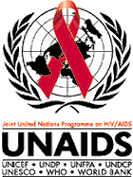


Acknowledgements
The Children and AIDS International Non-Government Organization Network (CAINN) wishes to thank UNAIDS for its generous support in funding these guidelines.
These guidelines were written by Jane Colling, with editing by Christine Hogg and Naomi Honigsbaum. Our sincere thanks go to the members of the CAINN steering group and other colleagues who commented on drafts and shared their experiences, and to Mildmay International who managed the project. Illustrations be David Wood.
For further copies of this booklet please contact:
UNAIDS
20 Avenue Appia
CH - 1211
Geneva 27
Switzerland
E-mail: unaids@unaids.org
UNAIDS, the Joint United Nations Programme on HIV/AIDS was established in January 1996 as a co-sponsored programme that brings together the United Nations Children's Fund (UNICEF), the United Nations Development Programme (UNDP), the United Nations Population Fund (UNFPA), the United Nations Educational, Scientific, and Cultural Organization (UNESCO), the World Health Organization (WHO), and the World Bank. As the main advocate for global action, UNAIDS leads, strengthens and supports an expanded response aimed at preventing the transmission of HIV, providing care and support, reducing the vulnerability of individuals and communities to HIV/AIDS, and alleviating the impact of the epidemic.
Introduction
| "Participation
is an acknowledgement of what children can do... It is recognition
that children... are also members of society and are thinking individuals
who are capable of expressing themselves, As such they too have a
say on matters and decisions which affect their lives, but also their
community and the larger society which they are part of."
Save the Children, Philippines. |
Children are living in a world with AIDS.
-
There are children who are themselves infected with HIV. By the end of 1997, 1.1 million children were living with HIV. AIDS is now the fifth leading cause of death amongst children of 1- 4 years, and seventh in young people between the ages of 15 and 24.
-
There are children who are uninfected but living in an infected family. More than 8 million children world-wide have already lost their mothers to AIDS, and at least 30 million are thought to be living with parents who are HIV positive. Of the people who died of AIDS in 1997, 2.3 million (46%) were women and 460,000 were children.
The voices of children and young people themselves are not often heard. These guidelines show how children and young people can be involved in education, prevention and care programmes related to HIV/AIDS. The extent and nature of their participation will vary in different countries, cultures and communities since the impact of HIV on families and on individuals varies and a child's place in society is viewed differently throughout the world.
These guidelines provide a framework for local projects to develop ways of working with children and young people that respect their rights and enable their voices to be heard. The definition of a child used throughout these guidelines is that set forth in the U.N. Convention on the Rights of the Child as "a human being under 18 years of age".
Why children and young people should participate
Only children and young people themselves can tell us what it means for them to live in a world with AIDS. The challenge is to work with them in a way that respects their views and gives them the freedom to participate on their own terms. The United Nations Convention on the Rights of the Child is a holistic set of standards for children and young people (see annex). The Convention provides the principles and framework for working with children and young people, including privacy, confidentiality, the role of the family, health and development. In particular, the Convention highlights the right of the child to participate (Article 12), suggesting that participation brings benefits for children and young people themselves and also the programs which encourage them to participate.
Building self-esteem and developing skills
By participating, children and young people have the opportunity to develop skills and confidence in areas which will benefit them and their communities. Through participation, children and young people learn about co-operation, mutual understanding and social responsibility. They may become better informed and equipped with new skills in communication and in thinking which will prepare them for adult life. When children and young people are better informed they are more able and likely to make decisions about their life for themselves. By meeting other youth in similar situations, they can give each other emotional support and realise that they are not alone.
Improving programmes
Programmes that are designed by adults to help children and young people may not always provide them with what they most need. Encouraging the participation of children and young people in the development of programmes is most likely to ensure that they are child-centered. Children and young people need to be involved in designing, monitoring and evaluating programmes.
Raising public awareness
Hearing what children and young people have to say often gives adults new insight into their wishes and needs, and provides relevant information about the activities and plans that can be undertaken to meet them. Greater public understanding may lead to changes in public policies and give youth more protection from prejudice. In addition, children and young people speaking for themselves may raise the profile of programmes and secure additional funding or other benefits. One large non-governmental organization (NGO) working with children in Southern Africa reported that the Government made financial contributions to children's projects and some children were given exemptions from educational fees, following their participation in World AIDS Campaign activities.
|
Changing public opinion using drama, poetry and song In Zambia when an adult dies, it is accepted that other relatives take the property of the dead person, often leaving the children without support. In order to draw attention to the consequences for them, children described their experiences in drama, poems, songs and panels and were able to express themselves in a culturally acceptable manner. "The emphasis was on the distress faced by the child, and not on the cause of the parents death because a child in distress is a child in distress, the cause of the distress is not of primary concern." Family Health Trust, Zambia 1998. |

Meeting the challenge
All children and young people can participate, if they so choose and if they feel it is likely to help them. Involving children and young people, without exploiting them or risking harm, requires skill and patience and, above all, respect for them and their views.
The two major challenges are:
- learning
to listen to children and young people.
- ensuring that their rights are respected, which is particularly important for those who are affected by HIV
Listening to children and young people
For children and young people to be empowered through participation, there needs to be:
- A genuine desire to listen to what children and young people have to say.
- A group of children and young people who want to be involved who share similar concerns.
- Workers with experience and skills to work with children and young people.
Adults are used to making decisions for children and young people. They often underestimate the understanding that even young children have and their ability to express their views - if given the opportunity. Developing trust between children and adults is essential in promoting children's participation and may take time. Children and young people need to feel safe before trusting other people enough to talk openly. Listening to children and young people needs patience and a supportive environment where they feel that they are respected and have the time to think about what they want to say. Children and young people may feel more comfortable where participation occurs within the normal, every day contexts of their lives such as school and community groups, youth and peer groups. This means that their lives are not disrupted and the programme is more likely to survive long term.
|
Ethical issues that underpin work with children and young people affected by AIDS All children's programmes should promote the rights and interests of children and young people, and restore or maintain their dignity.
|
Protecting children's confidentiality
It is important that children's identity and privacy are protected unless those participating specify otherwise. What participation involves and may mean should be fully discussed with them and measures taken to ensure that they are comfortable with their participation, other participants and the environment or social situation. Children and young people may find it difficult to refuse when they are asked by adults to participate, or may not even understand that they can say no. Where there are rewards offered for participation, there may be particular temptations for parents and children who are poor to participate in ways that may damage them. For example, pictures of children that portray them in a negative or disadvantaged way, may expose their identity and increase the risk of prejudice, discrimination and stereotyping.
|
Publicity and people living with HIV - a caution
|
Preparing and supporting children and young people
Involving children and young people in programmes must be properly resourced so that there is enough time to prepare children and provide them with support afterwards. The process of getting children to participate should involve:
- Making sure children know what participation involves.
- Support during the activity.
- Follow-up and debriefing afterwards.
A child's capacity to participate depends on individual and cultural factors and on their previous experience as much as their age. What may be appropriate for one may not appropriate for another. Differences between children and young people in terms of age, gender, disability, ethnicity, religion and family background must be taken into account. Before becoming involved, the social situation of the child should be considered, taking account of their developmental stage, emotional stability, support networks and their family situation. For example, in some families the older children may be aware of their parents or their own HIV status, while the younger children in the family may not.
Children and young people also need time for preparation and to be supported by their peers. Where children and young people become involved in the planning of programmes, they may have to make decisions and take more responsibility than they are used to. Most children with HIV have experienced trauma and difficulties and they and their families fear disclosure, ostracism, stigmatisation and transmission. They are concerned about the impact of the disease on their emotional and material resources as well as their ability to cope. Children and young people may feel that they will not be taken seriously and wonder if they will be able to put their feelings and experiences into words. Sometimes they find it distressing to talk about painful subjects and yet at the same time find it helpful to talk with someone honestly outside their immediate family.
If children and young people are participating in a single event, such as World AIDS Day, it is important to consider the impact on them and how they will feel when the programme ends. Where appropriate, children should be helped to consider how they would deal with personal questions that they do not want to answer. Support should be available during and after the event.
|
Should a child participate? Before a child or young person participates the following questions need to be considered and discussed with them.
|

Ways children and young people can participate
Participation should be a long-term process which is continually reviewed and adapted to meet changing needs. Where participation is viewed as a long-term process, rather than a single event, the results are more likely to be long lasting. Participation can take many different forms and there are different degrees of involvement which can be likened to the steps of a ladder, ranging from the superficial involvement of children and young people up to an equal partnership (as outlined in Figure 1).
|
Figure 1: How children and young people can be involved Children can be involved in many different ways and to different degrees. Assigned
but informed Consulted
and informed Adult
initiated Child
initiated Equal
partnerships Manipulation
and decoration Tokenism NOTE: it is important that programs avoid manipulation and decoration, where adults use children to promote a cause, or tokenism, where children may be involved but do not decide the means or subject of their involvement. Based on Hart. R (1992) Children's Participation: From Tokenism to Citizenship, Florence, International Child Development Centre, UNICEF. |
Projects should be interesting and fun for children and young people. At the outset children and young people themselves should decide the ways that they wish to be involved and how they want to communicate their views, experiences and needs. Children and young people should be partners from the start, with projects working with them, not just for them. Children and young people can explore creative solutions to problems that they consider to be important.
|
"Tokenism" In the Philippines, a group of youth facilitators/peer counsellors was approached by the organizers of the World AIDS Campaign 1998 and requested to formulate a concept paper on the programme for the World AIDS Day launch. When the youth submitted their proposal, a lengthy discussion took place with the organizers whether the event should be held in a local community setting (the youth's proposal) or in a shopping center. Everyone agreed to the proposal of the youths and preliminary arrangements were made with the community identified for the launching, Soon after, a notice was sent out by the Launch organizers announcing that the World AIDS Day launch would be held in a local, upperclass mall, a very different concept from the original plan. This occurrence is an example of "tokenism". The youth felt that it was not only a violation of their participation rights but a clear manifestation that there is no clear cut definition of the concept of a 'child's participation'. They had been invited to participate but not consulted when there were changes made. |
Below are examples of ways that children of different ages can be involved as groups or as individuals. All programmes should aim to empower children and increase their self-esteem. The most appropriate way will depend on the purpose of participation and the views of the children. Is the purpose, for example:
- To help individual children understand more about HIV and AIDS and to cope better?
- To find out what help and services children and young people would like?
- To raise awareness of children's views and overcome public prejudice about HIV/AIDS?
Helping individual children and young people
There are many different ways of helping children and young people understand and come to terms with HIV and how it affects their lives.
Writing
and pictures
Children and young people can present their ideas and experiences in writing
or in pictures.
- Poetry: children and young people can express their feelings in poems, often more easily than in other writing.
- Story-telling and writing: children and young people can write about their experiences or a topic. It may help to invite them to write on a theme such as their family, their fears, or their community.
- Pictures and art: for example, children and young people can use art to express the feelings of loss and reaction to sickness. Art that the children and young people have prepared previously could be displayed.
|
Hong Kong 'Healthy Young Ambassadors Scheme' "In the Hong Kong AIDS Foundation, we have a special scheme targeted at young people called the 'Healthy Young Ambassador Scheme. This scheme aims at training up young people as peer educators on AIDS. The scheme has been very successful in attracting students studying in Universities in Hong Kong and they have now become an independent group which plans for their own education programs and advises the Foundation on youth programs. " |

